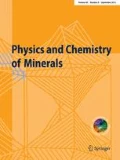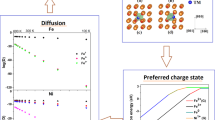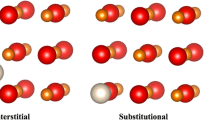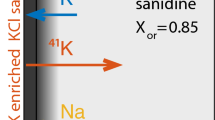Abstract
The neon diffusion behavior in goethite has been investigated for the purpose of geological (U-Th)/Ne dating, as Ne produced in goethite by nucleogenic reactions related to natural U and Th alpha decay can diffuse out of the crystal. According to previous works, a multi-scale computational approach combining Density Functional Theory studies at the atomic scale and Kinetic Monte Carlo simulations at the macroscopic scale has been used to determine Ne diffusion behavior in goethite. Periodic-DFT calculations have been performed to study the structural, electronic, and magnetic properties of goethite, and therefore to identify the Ne insertion sites in pure defect-free goethite as well as in goethite containing iron-aluminum substitution and goethite containing crystallographic defects, to obtain a crystal structure closest to a natural goethite crystal. The Nudged Elastic Band method was used to define the minimum energy pathway for Ne migration, between neighboring interstitial sites. The Climbing Image Nudged Elastic Band method was adopted to obtain more accuracy on the transition state. The 3-dimensional random walk of Ne jumps between interstitial sites was simulated using the Kinetic Monte Carlo method. We found that a Ne atom diffuses in pure defect-free goethite following a zig-zag pathway along the unoccupied channel of goethite, with an effective activation energy of Ea = 0.50 eV and a pre-exponential factor of D0 = 6.38 × 10–4 cm2 s−1. Moreover, the iron-aluminum substitution induces a small volume contraction of the unoccupied channel, which increases the energy barrier of Ne diffusion to 0.66 eV. Nevertheless, this energy barrier remains insufficient to retain Ne atom in the goethite structure at surface temperature. However, crystallographic defects impact strongly Ne diffusivity in goethite. In the case of a Schottky defect, i.e. a large vacancy, the Ne atom is retained in the new stable site generated by the vacancy. In the case of a hydrated Fe vacancy, steric constraints remain a barrier that inhibit the Ne jumping between two adjacent unoccupied channels.









Similar content being viewed by others
References
Alexandrov V, Rosso KM (2014) Electron transport in pure and substituted iron oxyhydroxides by small-polaron migration. J Chem Phys 140:234701. https://doi.org/10.1063/1.4882065
Allard T, Gautheron C, Bressan Riffel S et al (2018) Combined dating of goethites and kaolinites from ferruginous duricrusts. Deciphering the Late Neogene erosion history of Central Amazonia. Chem Geol 479:136–150. https://doi.org/10.1016/j.chemgeo.2018.01.004
Ault AK, Gautheron C, King GE (2019) Innovations in (U–Th)/He, fission track, and trapped charge thermochronometry with applications to earthquakes, weathering, surface-mantle connections, and the growth and decay of mountains. Tectonics. https://doi.org/10.1029/2018TC005312
Balout H, Roques J, Gautheron C et al (2017a) Helium diffusion in pure hematite (α-Fe2O3) for thermochronometric applications: a theoretical multi-scale study. Comput Theor Chem 1099:21–28. https://doi.org/10.1016/j.comptc.2016.11.001
Balout H, Roques J, Gautheron C, Tassan-Got L (2017b) Computational investigation of interstitial neon diffusion in pure hematite. Comput Mater Sci 128:67–74. https://doi.org/10.1016/j.commatsci.2016.10.005
Bazilevskaya E, Archibald DD, Aryanpour M et al (2011) Aluminum coprecipitates with Fe (hydr)oxides: does isomorphous substitution of Al3+ for Fe3+ in goethite occur? Geochim Cosmochim Acta 75:4667–4683. https://doi.org/10.1016/j.gca.2011.05.041
Blanchard M, Morin G, Lazzeri M, Balan E (2010) First-principles study of the structural and isotopic properties of Al- and OH-bearing hematite. Geochim Cosmochim Acta 74:3948–3962. https://doi.org/10.1016/j.gca.2010.04.018
Blöchl PE (1994) Projector augmented-wave method. Phys Rev B 50:17953–17979. https://doi.org/10.1103/PhysRevB.50.17953
Bocquet JL (2002) On-the-fly evaluation of diffusional parameters during a Monte Carlo simulation of diffusion in alloys: a challenge. Defect Diffus Forum 203–205:81–112
Bocquet S, Kennedy SJ (1992) The Néel temperature of fine particle goethite. J Magn Magn Mater 109:260–264. https://doi.org/10.1016/0304-8853(92)91758-L
Bortz AB, Kalos MH, Lebowitz JL (1975) A new algorithm for Monte Carlo simulation of Ising spin systems. J Comput Phys 17:10–18. https://doi.org/10.1016/0021-9991(75)90060-1
Canola S, Negri F (2014) Anisotropy of the n-type charge transport and thermal effects in crystals of a fluoro-alkylated naphthalene diimide: a computational investigation. Phys Chem Chem Phys 16:21550–21558. https://doi.org/10.1039/C4CP03231D
Cornell RM, Schwertmann U (2004) The iron oxides: structure, properties, reactions, occurences and uses, 2nd edn. Wiley, Weinheim
Djimbi D-M, Gautheron C, Roques J et al (2015) Impact of apatite chemical composition on (U-Th)/He thermochronometry: an atomistic point of view. Geochim Cosmochim Acta 167:162–176. https://doi.org/10.1016/j.gca.2015.06.017
Dodson MH (1973) Closure temperature in cooling geochronological and petrological systems. Contrib Miner Petrol 40:259–274. https://doi.org/10.1007/BF00373790
Dudarev SL, Liechtenstein AI, Castell MR et al (1997) Surface states on NiO (100) and the origin of the contrast reversal in atomically resolved scanning tunneling microscope images. Phys Rev B 56:4900–4908. https://doi.org/10.1103/PhysRevB.56.4900
Einstein A (1905) Über die von der molekularkinetischen Theorie der Wärme geforderte Bewegung von in ruhenden Flüssigkeiten suspendierten Teilchen. Ann Phys 322:549–560. https://doi.org/10.1002/andp.19053220806
Elber R, Karplus M (1987) A method for determining reaction paths in large molecules: application to myoglobin. Chem Phys Lett 139:375–380. https://doi.org/10.1016/0009-2614(87)80576-6
Farley KA, Flowers RM (2012) (U–Th)/Ne and multidomain (U–Th)/He systematics of a hydrothermal hematite from eastern Grand Canyon. Earth Planet Sci Lett 359–360:131–140. https://doi.org/10.1016/j.epsl.2012.10.010
Fleisch J, Grimm R, Grübler J, Gütlich P (1980) Determination of the aluminum content of natural and synthetic aluminogoethites using Mössbauer spectroscopy. J Phys 41:169–170
Forsyth JB, Hedley CE, Johnson IG (1968) The magnetic structure and hyperfine field of goethite (α-FeOOH). J Phys C Solid State Phys 1:179
Fuente SA, Belelli PG, Castellani NJ, Avena M (2013) LDA + U and GGA + U studies of Al-rich and bulk goethite (α-FeOOH). Mater Chem Phys 137:1012–1020. https://doi.org/10.1016/j.matchemphys.2012.11.017
Gautheron CE, Tassan-Got L, Farley KA (2006) (U–Th)/Ne chronometry. Earth Planet Sci Lett 243:520–535. https://doi.org/10.1016/j.epsl.2006.01.025
Gautheron C, Djimbi DM, Roques J et al (2020) A multi-method, multi-scale theoretical study of He and Ne diffusion in zircon. Geochim Cosmochim Acta 268:348–367. https://doi.org/10.1016/j.gca.2019.10.007
Gerin C, Gautheron C, Oliviero E et al (2017) Influence of vacancy damage on He diffusion in apatite, investigated at atomic to mineralogical scales. Geochim Cosmochim Acta 197:87–103. https://doi.org/10.1016/j.gca.2016.10.018
Gillespie DT (1976) A general method for numerically simulating the stochastic time evolution of coupled chemical reactions. J Comput Phys 22:403–434. https://doi.org/10.1016/0021-9991(76)90041-3
Guo H, Barnard AS (2011) Modeling the iron oxides and oxyhydroxides for the prediction of environmentally sensitive phase transformations. Phys Rev B 83:094112. https://doi.org/10.1103/PhysRevB.83.094112
Hahn T (1996) International tables for crystallography: brief teaching edition of volume A—the Fourth revised and enlarged Teaching Edition. Kluwer Academic Publishers, Dordrecht, London
Henkelman G, Uberuaga BP, Jónsson H (2000) A climbing image nudged elastic band method for finding saddle points and minimum energy paths. J Chem Phys 113:9901–9904. https://doi.org/10.1063/1.1329672
Hohenberg P, Kohn W (1964) Inhomogeneous electron gas. Phys Rev 136:B864–B871. https://doi.org/10.1103/PhysRev.136.B864
Jónsson H, Mills G, Jaconsen KW (1998) Nudged elastic band method for finding minimum energy paths of transitions. In: Berne BJ, Ciccotti G, Coker DF (eds) Classical and quantum dynamics in condensed phase simulations, pp 385–404
Ko H, Deng J, Szlufarska I, Morgan D (2016) Ag diffusion in SiC high-energy grain boundaries: Kinetic Monte Carlo study with first-principle calculations. Comput Mater Sci 121:248–257. https://doi.org/10.1016/j.commatsci.2016.04.027
Kohn W, Sham LJ (1965) Self-consistent equations including exchange and correlation effects. Phys Rev 140:A1133–A1138. https://doi.org/10.1103/PhysRev.140.A1133
Kresse G, Hafner J (1993) Ab initio molecular dynamics for liquid metals. Phys Rev B 47:558–561. https://doi.org/10.1103/PhysRevB.47.558
Kresse G, Furthmüller J (1996) Efficient iterative schemes for ab initio total-energy calculations using a plane-wave basis set. Phys Rev B 54:11169–11186. https://doi.org/10.1103/PhysRevB.54.11169
Kresse G, Joubert D (1999) From ultrasoft pseudopotentials to the projector augmented-wave method. Phys Rev B 59:1758–1775. https://doi.org/10.1103/PhysRevB.59.1758
Laidler KJ (1996) A glossary of terms used in chemical kinetics, including reaction dynamics (IUPAC Recommendations 1996). Pure Appl Chem 68:149. https://doi.org/10.1351/pac199668010149
Leetmaa M, Skorodumova NV (2015) Mean square displacements with error estimates from non-equidistant time-step kinetic Monte Carlo simulations. Comput Phys Commun 191:119–124. https://doi.org/10.1016/j.cpc.2015.02.006
Li W-Y, Zhang Y, Zhou H-B et al (2011) Stress effects on stability and diffusion of H in W: a first-principles study. Comput Simul Radiat Eff Solids 269:1731–1734. https://doi.org/10.1016/j.nimb.2010.12.027
Liu H, Chen T, Frost RL (2014) An overview of the role of goethite surfaces in the environment. Chemosphere 103:1–11. https://doi.org/10.1016/j.chemosphere.2013.11.065
Meslin E, Fu C-C, Barbu A et al (2007) Theoretical study of atomic transport via interstitials in dilute $\mathrmFe\text\ensuremath-\mathrmP$ alloys. Phys Rev B 75:094303. https://doi.org/10.1103/PhysRevB.75.094303
Michalet X (2010) Mean square displacement analysis of single-particle trajectories with localization error: Brownian motion in an isotropic medium. Phys Rev E 82:041914. https://doi.org/10.1103/PhysRevE.82.041914
Monkhorst HJ, Pack JD (1976) Special points for Brillouin-zone integrations. Phys Rev B 13:5188–5192. https://doi.org/10.1103/PhysRevB.13.5188
Nasdala L, Wenzel M, Vavra G et al (2001) Metamictisation of natural zircon: accumulation versus thermal annealing of radioactivity-induced damage. Contrib Miner Petrol 141:125–144. https://doi.org/10.1007/s004100000235
Norrish K, Taylor RM (1961) The isomorphous replacement of iron by aluminium in soil goethites. J Soil Sci 12:294–306
Özdemir Ö, Dunlop DJ (1996) Thermoremanence and Néel temperature of goethite. Geophys Res Lett 23:921–924. https://doi.org/10.1029/96GL00904
Perdew JP, Burke K, Ernzerhof M (1996) Generalized gradient approximation made simple. Phys Rev Lett 77:3865–3868. https://doi.org/10.1103/PhysRevLett.77.3865
Pratt LR (1986) A statistical method for identifying transition states in high dimensional problems. J Chem Phys 85:5045–5048. https://doi.org/10.1063/1.451695
Rohrbach A, Hafner J, Kresse G (2003) Electronic correlation effects in transition-metal sulfides. J Phys Condens Matter 15:979
Rollmann G, Rohrbach A, Entel P, Hafner J (2004) First-principles calculation of the structure and magnetic phases of hematite. Phys Rev B 69:165107. https://doi.org/10.1103/PhysRevB.69.165107
Russell B, Payne M, Ciacchi LC (2009) Density functional theory study of Fe(II) adsorption and oxidation on goethite surfaces. Phys Rev B 79:165101. https://doi.org/10.1103/PhysRevB.79.165101
Schulze DG, Schwertmann U (1984) The influence of aluminium on iron oxides: X. properties of Al- substituted goethites. Clay Miner 19:521–539. https://doi.org/10.1180/claymin.1984.019.4.02
Schwertmann U, Carlson L (1994) Aluminum influence on Iron oxides: XVII. Unit-cell parameters and aluminum substitution of natural goethites. Soil Sci Soc Am J 58:256–261. https://doi.org/10.2136/sssaj1994.03615995005800010039x
Sherman DM (2005) Electronic structures of iron(III) and manganese(IV) (hydr)oxide minerals: thermodynamics of photochemical reductive dissolution in aquatic environments. Geochim Cosmochim Acta 69:3249–3255. https://doi.org/10.1016/j.gca.2005.01.023
Shuster DL, Vasconcelos PM, Heim JA, Farley KA (2005) Weathering geochronology by (U-Th)/He dating of goethite. Geochim Cosmochim Acta 69:659–673. https://doi.org/10.1016/j.gca.2004.07.028
Soisson F, Becquart CS, Castin N et al (2010) Atomistic Kinetic Monte Carlo studies of microchemical evolutions driven by diffusion processes under irradiation. FP6 IP PERFECT Proj Predict Irradiat Damage Eff React Compon. J Nucl Mater 406:55–67. https://doi.org/10.1016/j.jnucmat.2010.05.018
Svante A (1889) Über die Dissociationswärme und den Einfluss der Temperatur auf den Dissociationsgrad der Elektrolyte. Z Für Phys Chem 4U:96. https://doi.org/10.1515/zpch-1889-0408
Szytuła A, Burewicz A, Dimitrijević Ž et al (1968) Neutron diffraction studies of α-FeOOH. Phys Status Solid B 26:429–434. https://doi.org/10.1002/pssb.19680260205
Tardy Y (1993) Pétrologie des latérites et des sols tropicaux / Yves Tardy. Masson, Paris
Trushin OS, Salo P, Alatalo M, Ala-Nissila T (2001) Atomic mechanisms of cluster diffusion on metal fcc(100) surfaces. Surf Sci 482–485:365–369. https://doi.org/10.1016/S0039-6028(00)01013-X
Trushin O, Karim A, Kara A, Rahman TS (2005) Self-learning kinetic monte carlo method: application to Cu(111). Phys Rev B 72:115401. https://doi.org/10.1103/PhysRevB.72.115401
Tunega D (2012) Theoretical study of properties of goethite (α-FeOOH) at ambient and high-pressure conditions. J Phys Chem C 116:6703–6713. https://doi.org/10.1021/jp2091297
van der Zee C, Roberts DR, Rancourt DG, Slomp CP (2003) Nanogoethite is the dominant reactive oxyhydroxide phase in lake and marine sediments. Geology 31:993–996. https://doi.org/10.1130/G19924.1
Vasconcelos PM, Heim JA, Farley KA et al (2013) 40Ar/39Ar and (U–Th)/He – 4He/3He geochronology of landscape evolution and channel iron deposit genesis at Lynn Peak, Western Australia. Geochim Cosmochim Acta 117:283–312. https://doi.org/10.1016/j.gca.2013.03.037
Vasconcelos A, Meyer K, Campello M (2015) Mamíferos quaternários da cavidade ES-08, Município de Prudente de Morais, Minas Gerais: análises tafonômica e taxonômica. Rev Bras Paleontol 18:171–190. https://doi.org/10.4072/rbp.2015.1.12
Veiga RGA, Perez M, Becquart CS et al (2010) Effect of the stress field of an edge dislocation on carbon diffusion in $\ensuremath{\alpha}$-iron: Coupling molecular statics and atomistic kinetic Monte Carlo. Phys Rev B 82:054103. https://doi.org/10.1103/PhysRevB.82.054103
Vineyard GH (1957) Frequency factors and isotope effects in solid state rate processes. J Phys Chem Solid 3:121–127. https://doi.org/10.1016/0022-3697(57)90059-8
Vladimir IA, Aryasetiawan F, Lichtenstein AI (1997) First-principles calculations of the electronic structure and spectra of strongly correlated systems: the LDA + U method. J Phys Condens Matter 9:767
Voter AF (1986) Classically exact overlayer dynamics: diffusion of rhodium clusters on Rh(100). Phys Rev B 34:6819–6829. https://doi.org/10.1103/PhysRevB.34.6819
Wert C, Zener C (1949) Interstitial atomic diffusion coefficients. Phys Rev 76:1169–1175. https://doi.org/10.1103/PhysRev.76.1169
Xu Y, Roques J, Domain C, Simoni E (2016) Carbon diffusion in bulk hcp zirconium: a multi-scale approach. J Nucl Mater 473:61–67. https://doi.org/10.1016/j.jnucmat.2016.02.010
Yang H, Lu R, Downs RT, Costin G (2006) Goethite, [alpha]-FeO(OH), from single-crystal data. Acta Crystallogr Sect E 62:i250–i252
Yang J-H, Park J-S, Kang J, Wei S-H (2015) First-principles multiple-barrier diffusion theory: the case study of interstitial diffusion in CdTe. Phys Rev B 91:075202. https://doi.org/10.1103/PhysRevB.91.075202
Yen AS, Gellert R, Schröder C et al (2005) An integrated view of the chemistry and mineralogy of martian soils. Nature 436:49–54. https://doi.org/10.1038/nature03637
Yin S, Ellis DE (2009) DFT studies of Cr(VI) complex adsorption on hydroxylated hematite (11¯02) surfaces. Surf Sci 603:736–746. https://doi.org/10.1016/j.susc.2009.01.015
Acknowledgements
This study and F. Bassal salary were funded by the Agence National de la Recherche—grant no. ANR-17-CE01-0012—RECA: RElation entre le Changement climatique et formation des lAtérites. All calculations were performed on the radiochemistry team's HPC cluster at the "Institut de Physique Nucléaire d'Orsay" (Orsay, France). We would like to thank Christophe Diarra for his precious help in managing the IPNO cluster (GRIF) and also Thierry Allard and Guillaume Morin for the meaningful discussions during the writing.
Author information
Authors and Affiliations
Corresponding author
Additional information
Publisher's Note
Springer Nature remains neutral with regard to jurisdictional claims in published maps and institutional affiliations.
Rights and permissions
About this article
Cite this article
Bassal, F., Roques, J. & Gautheron, C. Neon diffusion in goethite, α-FeO(OH): a theoretical multi-scale study. Phys Chem Minerals 47, 14 (2020). https://doi.org/10.1007/s00269-020-01083-w
Received:
Accepted:
Published:
DOI: https://doi.org/10.1007/s00269-020-01083-w




